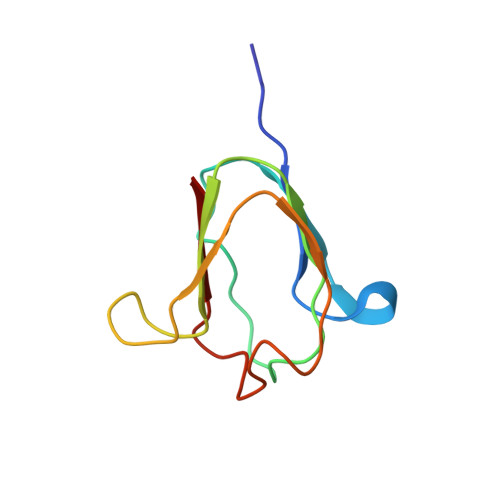Solution structure and calcium-binding properties of M-crystallin, a primordial betagamma-crystallin from archaea.
Barnwal, R.P., Jobby, M.K., Devi, K.M., Sharma, Y., Chary, K.V.(2009) J Mol Biol 386: 675-689
- PubMed: 19138688
- DOI: https://doi.org/10.1016/j.jmb.2008.12.058
- Primary Citation of Related Structures:
2K1W, 2K1X - PubMed Abstract:
The lens betagamma-crystallin superfamily has many diverse but topologically related members belonging to various taxa. Based on structural topology, these proteins are considered to be evolutionarily related to lens crystallins, suggesting their origin from a common ancestor. Proteins with betagamma-crystallin domains, although found in some eukaryotes and eubacteria, have not yet been reported in archaea. Sequence searches in the genome of the archaebacterium Methanosarcina acetivorans revealed the presence of a protein annotated as a betagamma-crystallin family protein, named M-crystallin. Solution structure of this protein indicates a typical betagamma-crystallin fold with a paired Greek-key motif. Among the known structures of betagamma-crystallin members, M-crystallin was found to be structurally similar to the vertebrate lens betagamma-crystallins. The Ca(2+)-binding properties of this primordial protein are somewhat more similar to those of vertebrate betagamma-crystallins than to those of bacterial homologues. These observations, taken together, suggest that amphibian and vertebrate betagamma-crystallin domains are evolutionarily more related to archaeal homologues than to bacterial homologues. Additionally, identification of a betagamma-crystallin homologue in archaea allows us to demonstrate the presence of this domain in all the three domains of life.
Organizational Affiliation:
Department of Chemical Sciences, Tata Institute of Fundamental Research, Homi Bhabha Road, Colaba, Mumbai 400005, India.















